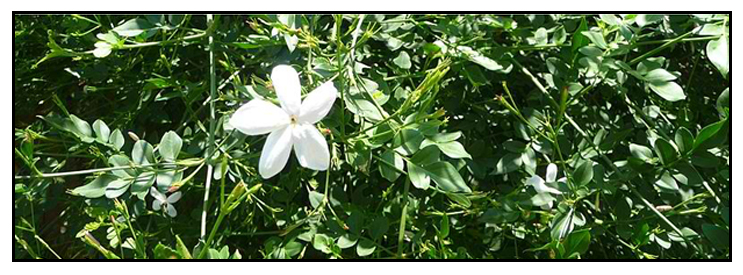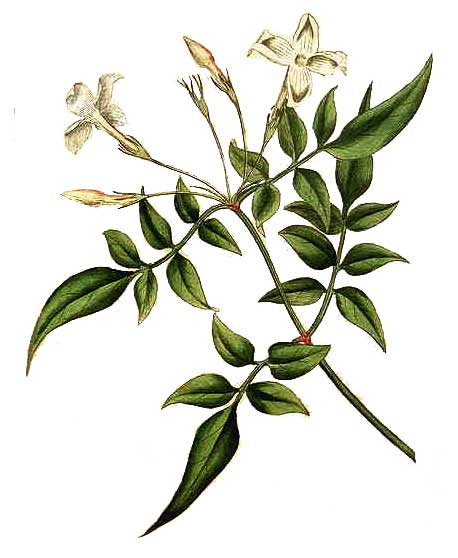
Botany
Jasmin is a smooth, woody vine, reaching a length of 8 meters, often with pendulous branches. Leaves are odd-pinnate, 6 to 9 centimeters long, with 7 to 9 leaflets. Lower leaflets are shortly stalked, while the upper ones are stalkless and often somewhat fused; both are ovate, 1 to 2 centimeters long, and pointed at the tip. Flowers are white with faint, pinkish streaks or a purplish tinge outside, delightfully fragrant, and borne in lax, terminal inflorescences. Calyx-teeth are very slender, about 7 millimeters long. Corolla is white, with a slender tube nearly 2 centimeters long; the spreading lobes about 1.5 centimeters long.
 Distribution Distribution
- Cultivated in Manila and other large towns for its very fragrant flowers.
- Nowhere spontaneous.
- Native of India.
Constituents
- Flowers contain a volatile oil, jasminol, and indol.
-
Essence also contains benzyl-acetate, linalol, indol, and a ketone called jasmone.
- Ethereal extract from the leaves yield an alkaloid, jasminine.
- Study reports salicylic acid and an astringent principle in the leaves.
- Study yielded moderate phenols and abundant flavonoids and terpenoids.
- Phytochemical screening yielded alkaloids, glycoside, flavonoid, triterpenes, saponins, tannin, resin, and salicylic acid.
- Phytochemical screening of leaves yielded glyceryl behenate (2,3-dihydroxypropyl docosanoate) (1), glycerol cerotate (2,3-dihydroxypropyl 1-hexacosanoate) (2), cerotyl O-β-D-diarabinoside (n-hexacosanoyl-O-β-D- arabinopyranosyl-(2ʹ→1″)-O-β-D- arabinopyranoside / cerotyl O-β-D-arabinopyranosyl-(2ʹ→1ʹʹ)-O-β-D-arabinopyranoside (3), stearyl-O-α-D-triglucoside (stearyl glucopyranosyl-(6′→1′′)-O-α-D- glucopyranosyl-(6′′→1′′′)-O-α-D- glucopyranoside (4), and behenyl-O-α-D-glucopyranosyl-(6’→1″)-O-α-D-glucopyranosyl-(6’′→1″′)-O-α-D-glucopyranoside (5). (23)
-GC-MS analysis of flowers for essential oil yielded 30 compounds representing 99.28% of the oil content. Major volatile components were 3,7,11,15-tetramethyl-2-hexadecen-1-l (phytol) (25.77%), 3,7,11-trimethyldodeca-1,6,10-trien-3-ol (12.54%), and 3,7,11,15-tetramethyl-1-hexadecen-3-ol (12.42%). (27)
Properties
- Plant considered deobstruent, anthelmintic, diuretic, emmenagogue, anti-inflammatory, antimicrobial, anti-tumor, anticarcinogenic, aphrodisiac.
- In China, oil considered tonic.
- Tea considered calming and helpful for nervous debility.
- Studies have suggested anti-fertility, anti-hepatitis, antibacterial,
antifungal, antiulcer, antioxidant, wound healing, antinociceptive, anticonvulsant, cytotoxic, hepatoprotective, chemoprotective, nephroprotective properties.
Trivia
To extract 2.2 lb of jasmine essence, 2,200 lbs of fresh flowers are needed.
Parts used
Flowers, leaves, oil.
Uses
Edibility
- Flowers used for tea.
Folkloric
- In the Philippines, water in which the flowers were macerated the night before used as eyewash.
- Flowers macerated in oil or alcohol extract used for rheumatism.
- Cataplasm of flowers used as poultice to prevent the flow of milk.
- Leaves used in treating ulcerative stomatitis, ulcers, and wounds.
- Hindu physicians use the leaves as a remedy for skin diseases, ulcers of the mouth, and otorrhea.
- Fresh juice of leaves used to soften corns; oil prepared with it used for otorrhea.
- In Bhavaprakasa, the leaves are chewed for ulcerations of the mucous membranes of the mouth.
- In Ayurveda, used for skin diseases and wound healing.
- Plaster of flowers applied to the loins and pubes as an aphrodisiac.
- In south China, used for treatment of hepatitis.
- In China, oil used as tonic.
- In India, used to suppress lactation.
- Leaves used in preventing and treating cancers.
- In Thailand, infusion of flowers used as cosmetic after bathing.
- Fresh leaf juice chewed to treat buccal ulcerations.
Roots used for cephalalgia, mental debility, chronic constipation, flatulence, strangury dysmenorrhea, amenorrhea, ringworm, leprosy, skin diseases, and giddiness.
Others
- Cosmetics: In Siam, infusion of flowers used as cosmetic after bathing. Extracts used in facial moisturizing products, bleaching, anti-aging, lotions, sprays and shampoos.
- Flowers used in biotherapy, aromatherapy and perfumery.
Studies
• Flower Chemical Constituents / Secoiridois: Study isolated six secoiridoids from the flowers of J officinale: jasgranoside, jaspolyoside, 8-epi-kingiside, 10-hydroxy-oleuropein, 10-hydroxy-ligstroside, oleoside-7, 11-dimethyl ester. (1)
• Antifertility: Study of aqueous extract of JO on female fertility in rats showed a dose-dependent significant anti-implantation effect, but failed to produce complete infertility. Treatment from day 8 to day 20 of pregnancy did not produce any significant abortifacient activity. A significant decrease in serum progesterone on day 5 of pregnancy may be responsible for the anti-implantation effect. (2)
• Oleuropein / Anti-Hepatitis B: Oleuropein, derived from the flowers of Jasminum officinale effectively blocks HBsAg secretion in HepG cells in a dose-dependent manner. It also reduced viremia in DHBV-infected ducks. (3)
• Glycosides: Study isolated 7 glycosides from the flower of J officinale var grandiflorum. (4)
• Antibacterial: In a study on the antibacterial activity of extracts of J. grandiflorum and J. sambac, both showed effective activity against tested pathogens. J. grandiflorum scored highest with Salmonella typhi and lowest with Proteus mirabilis. (6)
• Anti-Ulcer / Leaves: Study of ethanolic extract of leaves in pyloric-ligated and aspirin-induced ulcer models in rats showed significant dose-dependent decrease in the ulcerative lesion index compared to the standard drug Omeprazole. The reduction in gastric fluid volume, free acid, total acid and increase in pH in rats proved an antisecretory and potential antiulcer activity of leaves of J. grandiflorum. (7)
• Antioxidant / Anti-Ulcer: Study of 70% ethanolic extract of leaves in rat showed dose-dependent decrease in the ulcerative lesion index in 3 ulcer models. The free radical scavenging activities of JGLE was dependent on concentration and the antiulcer activity may be attributed to its antioxidant mechanism of action. (8)
• Antifungal: Study exhibited antimycotic activity against fungi causing onychomycosis in cancer patients. without significant side effects. It significant retarded the growth of fungi Alternaria sp. (9)
• Chemopreventive / Anti-Lipid Peroxidative Potential: Study of an ethanol extract of Jg flowers on 7,12-dimethylbenz(a)anthracene (DMBA)-induced rat mammary carcinogenesis showed potent chemopreventive efficacy. It also exerted significant anti-lipid peroxidative effect and improved the antioxidant defense system in DMBA-treated rats. (10)
• Antihelmintic: Study of various extracts of Jg leaves against adult earthworm Pheretima posthuma showed the methanol, chloroform and aqueous extracts to show better anthelmintic activity compared with the standard drug albendazole. (11)
• Antibacterial / Fruits: Study evaluated fruit extracts of Jasminum grandiflorum for antibacterial activity. A methanol extract showed significant inhibitory effect against X. campestris and A. hydrophila, and suggests biocontrol purposes against bacterial infection in plants and animals. Aeromonas hydrophilia is one of the causative agents for diarrheal infections in children and immune compromised patients. Phytochemical analysis yielded steroids, sugars, reducing sugars, alkaloids, phenolic compounds and tannins. (12)
• Antinociceptive / Anticonvulsant / Leaves: Study evaluated a hydroalcoholic extract of leaves showed analgesic activity in the tail flick and acetic acid-induced writhing method and anticonvulsant activities by MES and PTZ method in rats and mice. (13)
• Protease Activity / Wound Healing / Floral Extract: Study evaluated a flower extract for protease activity. The floral extract showed higher protease activity when extracted at pH 4.0, and was maximum in stamens. Results suggest the protease activity may be responsible for the wound healing property of the flowers. (14)
• Protective Effect on DBMA-Induced Chromosomal Aberrations in Bone Marrow: Study investigated the protective effects of J. grandiflorum flowers and leaves in 7,12-dimethylbenz(a)anthracene (DMBA) induced chromosomal abnormalities in bone marrow in female wistar rats. Oral pretreatment with flower and leaf extracts significantly reduced the frequency of micronucleated polychromatic erythrocytes in the bone marrow, decreased the percentage of aberrant cells and the number of chromatic and chromosomal breaks. (15)
• Wound Healing Activity / Flowers: Study evaluated a flower extract for wound healing activity using excision and dead space wound models in rats. Results showed significantly increased hydroxyproline content in the dead space wound model. There was 65% reduction in wound area, and faster epithelization, and increased rate of wound contraction. (16)
• Genotoxic / Cytotoxic: Study evaluated the cytotoxic and genotoxic potential of petroleum ether and aqueous leaf extracts of J. officinale L. var. grandiflorum. The aqueous extract exhibited slightly higher chromosomal abnormal cells. Results showed the crude compound of leaf extracts is safer to use in ayurvedic preparation of the drug. (17)
• Hepatoprotective / INH-Induced Liver Damage: Study evaluated an ethanolic extract of leaves in isoniazid (INH) induced hepatotoxicity in wistar albino rats. Pretreatment of rats with JG showed hepatoprotective activity, with significantly decreased lipid peroxidation (LPO) and increased antioxidant activities. (18)
• Antibacterial / Leaves: Study screened various JG extracts for in vitro antibacterial activity. Results showed the petroleum ether, methanol and aqueous extracts were effective against all four test microorganisms, viz., S. aureus, B. subtilis, E. coli and Pseudomonas aeruginosa. (19)
• Antimicrobial / Leaves: Study evaluated various solvent extracts of leaves for antimicrobial activity. Results showed broad spectrum of activity for aqueous extracts, however, with comparatively higher concentrations. Fractionation of chloroform extract yielded two new antimicrobial compounds namely 3,5-dihydroxy-2,4-dimethuyl-hexanoic acid 4-hydroxy-phenyl ester (JHF-1) and 2-hydroxymethyl 1-3-methyl-butric acid phenyl ester (JHF-2). (20)
• Nephroprotective / Gentamicin Induced Nephrotoxicity: Study evaluated leaf extract for protective effects in gentamicin induced nephrotoxicity in Wistar rats. Results showed significant nephroprotective activity attributed to inherent antioxidant property and free radical scavenging principle contained in the extract. (21)
• Wound Healing Leaf Oil: Study evaluated the effect of leaf oil on various wound models in albino rats. Results showed significant decrease in periods of epithelization in excision wound (p<0.05) and burn wound (p<0.001) models. Wound contraction rate was also significantly increased in both models (p<0.001). (25)
• Wound Healing Effect by Histopathological Studies / Leaves: Study evaluated the wound healing effect of J. grandiflorum in albino rats by assessing histopathological parameters. Results showed jasmin paste improved wound healing processes at all stages. (26)
• Larvicidal Against Dengue and Chikungunya Vector A. aegypti / Flower: Dengue and chikungunya are transmitted by the vector mosquito Aedes aegypti. Study evaluated various flower extracts of Jasminum grandiflorum, J. officinale and J. auriculatum for larvicidal efficacy against third instar larvae of Aedes aegypti at concentrations ranging from 62.5 to 8000 mg/L. The crude chloroform extract of Jasminum grandiflorum was found to be effective with 100% mortality at 1000 mg/L with LC5o values of 344.01 and 300.47 after 24 and 48 hours, respectively. Results suggest potential as a natural insecticide of plant origin that is an ecofriendly and biodegradable alternative to synthetic insecticides. (29)
• Jasmine in Breastfeeding: In India, jasmine has been used to suppress lactation. Study has shown that jasmine leaves applied to the breasts suppressed postpartum lactation as effectively as oral bromocriptine. While the study was not considered of high quality, there is no studies that suggest jasmine may be harmful for nursing mothers or infants. Jasmine is "generally recognized as safe" (GRAS) as food ingredient by the US Food and Drug Administration. (30)
• Jasmine Essential Oil in Pregnancy and Labor: Because jasmine essential oil can cause strong contractions, it should be used only when labor is already underway. It should not be used to stimulate labor. (31)
Availability
Wild-crafted.
Oil, teas, extracts in the cybermarket.
|

![]()




 Distribution
Distribution